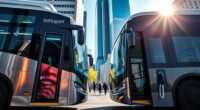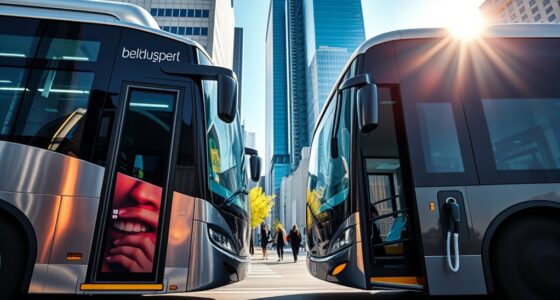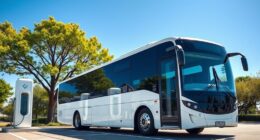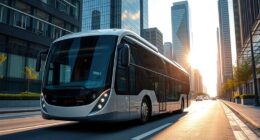By 2050, electric buses are expected to replace most traditional diesel buses worldwide, helped by urgent climate goals and advances in technology. Governments and transit agencies are investing heavily in charging infrastructure and sustainable solutions, aiming to eliminate fossil fuels from urban transit. Electric buses offer benefits like zero emissions, quieter operation, and lower maintenance. If you want to understand how this shift will unfold and impact your city, there’s much more to discover.
Key Takeaways
- Global plans aim for electric buses to replace diesel buses by 2050 to meet Net Zero emissions targets.
- Advances in charging infrastructure and technology support widespread adoption of electric buses.
- Electric buses offer environmental, social, and operational benefits, encouraging rapid market growth.
- Transition faces challenges like high initial costs, infrastructure needs, and technological development.
- While many regions aim for full electrification, complete global replacement by 2050 remains an optimistic goal.
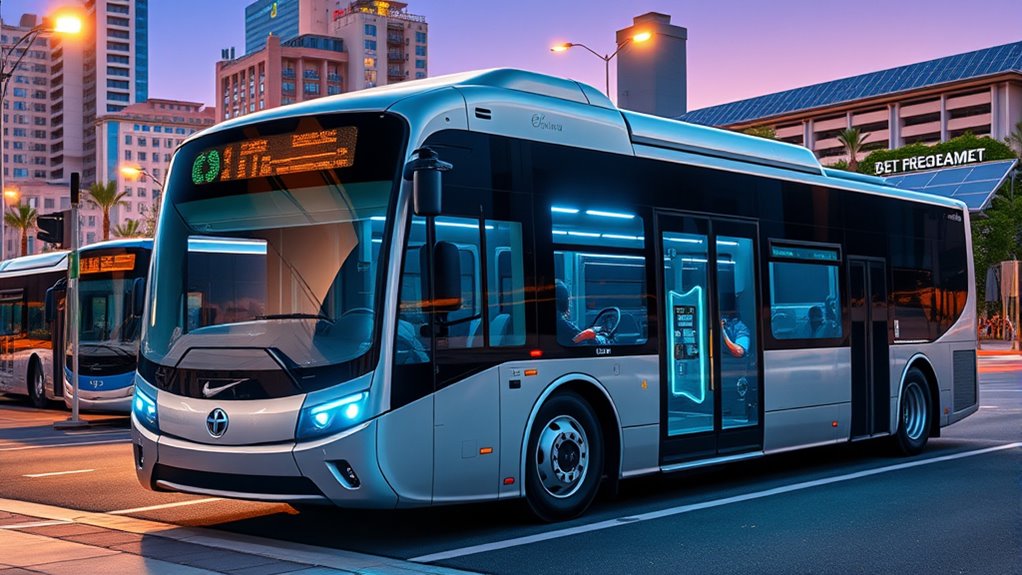
By 2050, electric buses are expected to replace traditional diesel-powered buses in cities worldwide, driven by the urgent need to meet Net Zero emissions targets. Governments and organizations have set ambitious goals to cut greenhouse gases, and electric buses are central to these plans. Transit agencies across the globe are actively integrating electric buses into their fleets, aiming for a complete shift that eliminates reliance on fossil fuels.
These electric models aren’t just cleaner; they’re also designed to improve passenger comfort and operational efficiency thanks to advanced technology and optimized layouts. Countries like Taiwan are leading the charge, showcasing how innovative electric bus solutions can help meet national sustainability objectives and set examples for others to follow.
Electric buses enhance passenger comfort and efficiency through advanced tech and innovative design, leading global sustainability efforts.
To support this change, key investments are pouring into charging infrastructure. Utilities and governments recognize that reliable, widespread charging stations are essential for smooth operation and long-term success. They’re planning extensively, ensuring that infrastructure keeps pace with fleet expansion, and federal funding is often pivotal.
Collaborative efforts between transit agencies and utility companies are crucial, providing the necessary power supply and developing efficient charging systems. These innovations aim to reduce charging times and energy consumption, making electric buses more practical for daily urban use. The development of smart energy management technologies further enhances operational efficiency, ensuring that electric buses can meet the demands of modern transit systems.
Replacing conventional buses with electric models dramatically impacts the environment. Electric buses emit zero tailpipe emissions, substantially reducing greenhouse gases and improving urban air quality. This change helps cities combat air pollution, leading to healthier communities.
Additionally, electric buses require less maintenance, which means fewer hazardous materials and less environmental hazard over their lifespan. They also operate more quietly, diminishing noise pollution in busy city centers. By shifting away from fossil fuels, electric buses promote more sustainable resource use, decreasing dependency on non-renewable energy sources and supporting broader environmental goals.
The electric bus market is expanding rapidly as technological advancements continue to make these vehicles more attractive and affordable. Many transit agencies have already committed to converting their entire fleets before 2050, driven by the decreasing costs and improving performance of electric models.
Massive investments are fueling this growth, with countries around the world setting concrete targets to adopt electric buses at scale. Overall, the trend points toward a future where electric buses dominate urban transportation, making cities cleaner, healthier, and more sustainable.
While challenges remain, the momentum and technological progress suggest that by 2050, electric buses will have largely replaced traditional diesel-powered vehicles in urban transit systems globally.
Frequently Asked Questions
What Are the Current Hurdles for Electric Bus Adoption Worldwide?
You face several hurdles in adopting electric buses worldwide. Battery limitations restrict range and power, while charging infrastructure faces grid instability and lack of standardization.
High upfront costs and unclear long-term savings make procurement tough. Institutional challenges like rigid procurement rules and weak coordination slow progress.
Additionally, grid capacity issues, land scarcity for stations, and market fragmentation hinder widespread adoption, making the shift complex and requiring coordinated efforts to overcome these obstacles.
How Will Electric Buses Impact Public Transportation Infrastructure Costs?
Electric buses will raise your public transportation infrastructure costs due to the need for significant charging stations and grid upgrades.
While they save money long-term through lower operating and maintenance costs, upfront investments are higher. You’ll need to plan carefully and allocate resources for infrastructure development.
Strategic charging options, like opportunity charging, can help optimize costs, but integrating electric buses into existing systems requires thoughtful planning and collaboration.
Are There Any Environmental Concerns Associated With Electric Bus Batteries?
Think of electric bus batteries like a double-edged sword. While they cut pollution and improve air quality, their mining and manufacturing can scar the environment, using lots of water and generating emissions.
If you don’t manage batteries responsibly at the end of their life, toxic chemicals could seep into soil and water. So, careful recycling and sustainable practices are essential to balance the benefits with environmental concerns.
What Policies Are Governments Implementing to Promote Electric Bus Use?
Governments are actively promoting electric bus use through a mix of policies. You’ll see subsidies covering up to half the purchase price, grants, and tax exemptions to lower costs.
Regulations set deadlines for zero-emission buses and restrict diesel in cities.
Infrastructure investments, like charging stations, are expanding, while support programs help train workers and develop better batteries.
These combined efforts make adopting electric buses more accessible and attractive for transit agencies.
How Do Electric Buses Compare in Longevity and Maintenance Costs?
You’ll find that electric buses have a lifespan similar to traditional diesel buses, lasting about 12 to 15 years with proper care.
Maintenance costs tend to be lower because they’ve fewer moving parts and don’t need emissions-related repairs.
Plus, regenerative braking reduces wear on brakes.
Conclusion
By 2050, electric buses could become the heartbeat of city streets, replacing traditional buses like a fresh pulse revitalizing the urban landscape. You’ll see cleaner air and quieter rides, transforming your daily commute into a smoother journey. While challenges remain, the shift to electric buses is a powerful wave of change, promising a future where transportation is greener and more sustainable. Embrace this revolution, and be part of the movement steering us toward a brighter, cleaner tomorrow.

